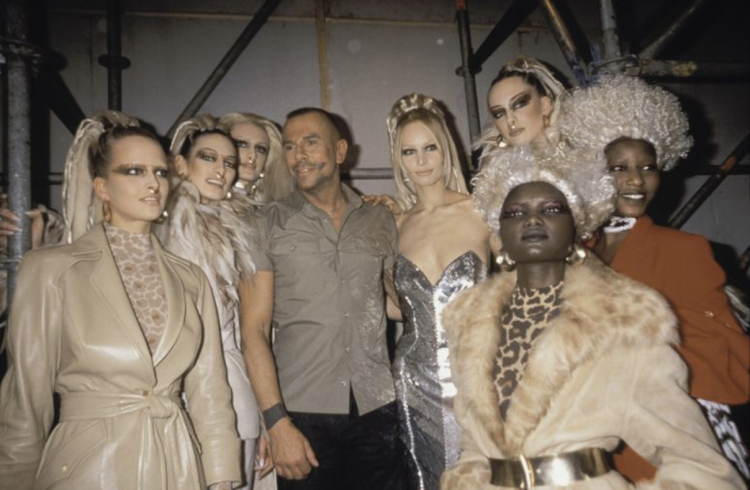Mugler and Westwood: The Fashion Industry’s Greatest Disruptors

The fashion industry in 2023 is still very far from being inclusive. Models are still predominantly white, thin and cisgender - not to mention that the industry is overrun with ‘nepo-babies.’
Enter Manfred Thierry Mugler and Dame Vivienne Westwood, two designers who rose to fame in the 80s and 90s. But what do the fantastical, spectacle-esque runway shows of Mugler, and the decadent, punk rock presentations of Westwood have in common?
The two designers are considered to be great disruptors of the fashion industry. Their skills were not only limited to corsets and crystal gowns, Mugler and Westwood, can also be recognized as pioneers of gender and racial inclusivity in high fashion.
When analyzing the years before and after Mugler and Westwood, there is a stark increase of inclusivity in high fashion events in terms of race, sexual orientation, and gender identity.
Thierry Mugler began his career by challenging prejudice in the 1980’s. He was an advocate during a period that saw the HIVAIDS Epidemic swept across the United States, when same-sex marriage wasn’t legal yet, and discrimination against the LGBTQ+ community was commonplace - so much so that the Director of Communications for the Reagan Administration, Pat Buchanan, publicly described AIDS as "nature's revenge on gay men.”
Referred to as ‘Fashion’s Greatest Showman,’ Mugler not only pioneered the shift toward a more inclusive fashion industry, but he also made designs that reinvented how the public viewed sexuality, self expression and the human body. Outside of his designs, he also championed diversity by casting queer and transgender models in his runway shows. These models brought new life to his designs, whilst championing the young, queer, and trans community.
In a piece for The Cut, the curator of Thiery Mugler, Couturissme, Thierry-Maxime Lorio, said, “if you wanted to become an insect or a superhero or a Hollywood vamp, Mugler was creating the garments to allow you to become whoever you want to be and stage your daily life.” Freedom of expression was Mugler’s trademark. Going against the status quo manifested in his work,his brand’s identity and carried over into how we view life and love. His Fall/Winter 1995 collection was a prime example of this, featuring hyper feminine, intense, sultry looks and a plethora of latex, BDSM styled outfits.
Hailed as the mother of punk and best known for her avant garde style, Viviane Westwood was an icon of the punk scene. She stood as a public figure to make political stands and had a proven track record of using her art in the later years of her career to make statements like casting models to present banners that declared a “Climate Revolution,” and t-shirts calling out big oil, and directly calling out politicians for controversial antiterrorism regulations.
Since the 1970’s, Westwood created designs emblematic of the budding punk movement sweeping across the Western world. It began when Westwood and one-time business partner, Malcolm McLaren, began creating clothing for the Sex Pistols. They opened a boutique with their creations called SEX, where they sold their designs that had t-shirts with politically charged slogans, fetish-inspired garments, and creations of leather and safety pins. What we’d classify today as punk.
The British designer was also a pioneer for inclusivity during the 70’s, 80’s and 90’s. Her brand and all that she stood for operated in stark contrast to the fashion industry at the time, and remains true still today. Although many outside the industry associate Westwood with her trademark corsets and pearl necklaces, she inspired those within the industry such as Jean-Paul Gautier, Dolce & Gabbana, and beyond.
Westwood was also known for donating large sums of money to the UK’s Green Party, publicly mocking Margaret Thatcher. She even cast environmental activists to walk in her runway shows; fearlessly making bold and potentially career ending moves for any designer. But, she had never been one to shy away from being controversial and standing up for what’s right.
In their prime, the work of Westwood and Mugler shocked the general public. From the ways in which they advocated for queer and trans people, celebrating them in their runway shows and daring to defy the status quo. Speaking out against environmental issues and corrupt politics, the two visionaries paved the way for many modern artists and the fight for inclusion in the fashion industry.
Prior to Mugler, LGBTQ+ people were hardly seen on a runway. Now, it’s far more commonplace in the industry for openly queer people to be seen in print, on TV, runways, as well as designing, and working in all sectors of fashion. Designers are also now arguably expected to take political stances on key issues like climate change and human rights.
This can be attributed to a number of different factors and the overall shifting socio-political landscape of the world, but in the fashion industry specifically, Westwood was amongst the first to use her status and platform to speak out in support of these causes.
All of this is by no means to say that we as a society are anywhere near done making progress as we still have quite a long way to go - especially in the fashion industry - but it’s worth noting just how far we’ve come, and honoring the work of the creatives like Mugler and Westwood who courageously defied standards and stood up for what they believed in through their art, paving the way for other creatives to do the same.







